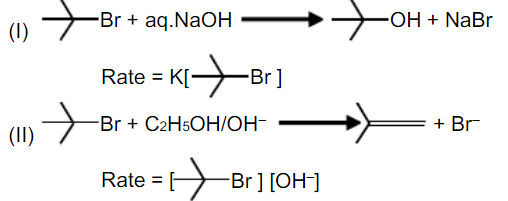Statement I Benzonitrile is prepared by the reaction of
chlorobenzene with potassium cyanide.
Statement II Cyanide is a strong nucleoohile.
Statement 1: is true Statement 2: is true, Statement 2 is the correct explainion of Statement 1
Statement 1 is true, Statement 2 is true, Statement 2 is not the correct explainion fo Statement 1.
Statement 1 is true, Statement 2 is false.
Statement 1 is false, Statement 2 is true.
To solve the question, we need to analyze both statements provided:
Statement I: Benzonitrile is prepared by the reaction of chlorobenzene with potassium cyanide.
Statement II: Cyanide (CN^(-)) is a strong nucleophile.
1. Evaluate Statement I:
- Benzonitrile (C6H5CN) is a compound where a cyanide group (CN) is attached to a benzene ring.
- The preparation of benzonitrile from chlorobenzene (C6H5Cl) would involve a nucleophilic substitution reaction where the cyanide ion (CN^(-)) would replace the chlorine atom.
- However, it is known that aryl halides, such as chlorobenzene, do not readily undergo nucleophilic substitution reactions under ordinary conditions due to the stability of the aromatic ring and the poor leaving ability of the halide ion.
- Therefore, this statement is incorrect.
2. Evaluate Statement II:
- The cyanide ion (CN^(-)) is indeed a strong nucleophile. Nucleophiles are species that donate an electron pair to form a chemical bond in a reaction.
- The carbon atom in the cyanide ion has a negative charge, making it highly reactive and capable of attacking electrophiles.
- Hence, this statement is correct.
3. Conclusion:
- Statement I is false because benzonitrile cannot be prepared from chlorobenzene and potassium cyanide due to the lack of reactivity of aryl halides in nucleophilic substitution.
- Statement II is true because cyanide is a strong nucleophile.
Final Answer:
- Statement I: False
- Statement II: True
Thus, the correct conclusion is that Statement I is false and Statement II is true.
- Benzonitrile (C6H5CN) is a compound where a cyanide group (CN) is attached to a benzene ring.
- The preparation of benzonitrile from chlorobenzene (C6H5Cl) would involve a nucleophilic substitution reaction where the cyanide ion (CN^(-)) would replace the chlorine atom.
- However, it is known that aryl halides, such as chlorobenzene, do not readily undergo nucleophilic substitution reactions under ordinary conditions due to the stability of the aromatic ring and the poor leaving ability of the halide ion.
- Therefore, this statement is incorrect.
- The cyanide ion (CN^(-)) is indeed a strong nucleophile. Nucleophiles are species that donate an electron pair to form a chemical bond in a reaction.
- The carbon atom in the cyanide ion has a negative charge, making it highly reactive and capable of attacking electrophiles.
- Hence, this statement is correct.
- Statement I is false because benzonitrile cannot be prepared from chlorobenzene and potassium cyanide due to the lack of reactivity of aryl halides in nucleophilic substitution.
- Statement II is true because cyanide is a strong nucleophile.
- Statement I: False
- Statement II: True
Topper's Solved these Questions
- AROMATIC COMPOUNDS AND ALKYL AND ARYL HALIDES BOOK - CENGAGE CHEMISTRY ENGLISHCHAPTER - AROMATIC COMPOUNDS AND ALKYL AND ARYL HALIDES EXERCISE - Archives Subjective
18 Videos
- AROMATIC COMPOUNDS AND ALKYL AND ARYL HALIDES BOOK - CENGAGE CHEMISTRY ENGLISHCHAPTER - AROMATIC COMPOUNDS AND ALKYL AND ARYL HALIDES EXERCISE - Archives Subjective Type
4 Videos
- AROMATIC COMPOUNDS AND ALKYL AND ARYL HALIDES BOOK - CENGAGE CHEMISTRY ENGLISHCHAPTER - AROMATIC COMPOUNDS AND ALKYL AND ARYL HALIDES EXERCISE - Archives Fill In Theblanks
12 Videos
- APPENDIX INORGANIC VOLUME 2BOOK - CENGAGE CHEMISTRY ENGLISHCHAPTER - APPENDIX INORGANIC VOLUME 2EXERCISE - Short Answer Type
179 Videos
- BIOMOLECULESBOOK - CENGAGE CHEMISTRY ENGLISHCHAPTER - BIOMOLECULESEXERCISE - Exercises Archives (Analytical And Descriptive)
8 Videos
Similar Questions
Complete the reaction :
Methyl bromide + Potassium cyanide to overset("Hydrolysis")to ?
View SolutionWrite equations for the reactions of
(i) iron with steam
(ii) calcium and potassium with water
View Solution
Correct statement regarding these two reaction I and II
View SolutionStatement -1 :An original solution containing excess of Ni2+ ions gives a yellow coloured solution with potassium cyanide solution.
Statement-2 :A solution of Ni2+ ions gives red precipitate with dimethylglyoxime solution just made alkaline with ammonia.
View SolutionMatch the reactions given in Column I with the statements given in Column II

View SolutionMatch the reactions given in Column I with the statements given in Column II

View SolutionStatement I The equation |(x−2)+a|=4 can have four distinct real solutions for x if a belongs to the interval (−∞,4).
Statemment II The number of point of intersection of the curve represent the solution of the equation.
(a)Both Statement I and Statement II are correct and Statement II is the correct explanation of Statement I
(b)Both Statement I and Statement II are correct but Statement II is not the correct explanation of Statement I
(c)Statement I is correct but Statement II is incorrect
(d)Statement II is correct but Statement I is incorrect
View SolutionWrite the reaction of EtOH with (i) KNH2 (ii) aq. KOH (iii) Potassium ethynide.
View SolutionStatement-1 :Cu2+ and Cd2+ ions form complexes with excess of potassium cyanide solution.
Statement-2 : On passing H2S gas, complex [Cu(CN)4]3− is not effected but [Cd(CN)4]2− gives yellow precipitated.
View SolutionStatement -1: Methyl isocyanide has higher boiling point than methyl cyanide. And
Statement -2: Methyl cyanide has co-ordinate bond between N and C.
View Solution
